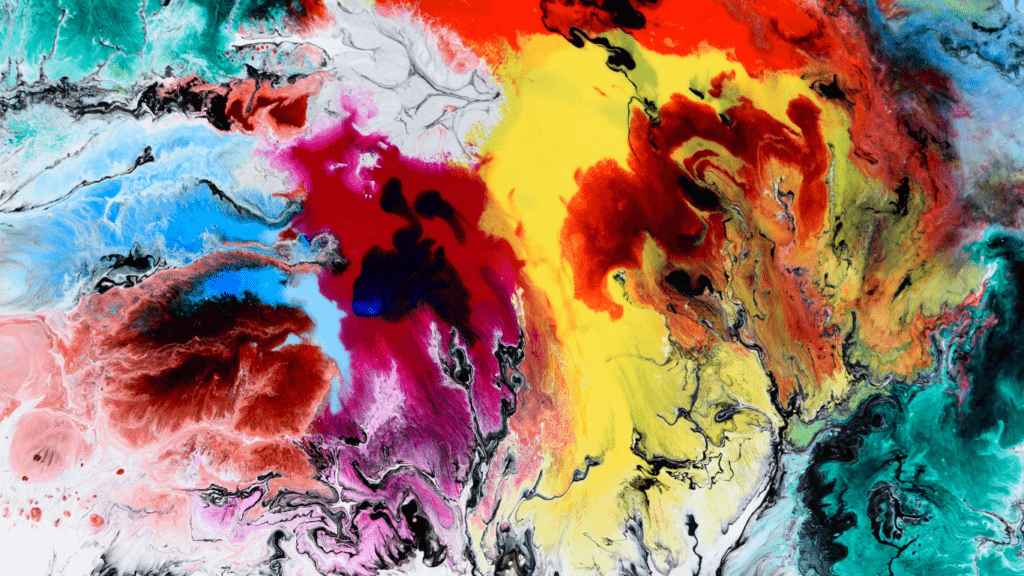Understanding Abstract Expressionism
Abstract Expressionism, emerging in the 1940s and 1950s, marked a radical departure from traditional art forms by emphasizing spontaneous artistic expression and conveying raw emotions.
Origins and Key Figures
The movement originated in the United States, primarily in New York. Key figures included Jackson Pollock and Mark Rothko. Pollock’s drip paintings typified this movement’s focus on spontaneity and dynamic composition. Rothko, known for his large color fields, explored emotional depth through bold color contrasts.
Core Concepts and Techniques
This movement centered on several core concepts. Artists emphasized the act of creation over the final product, valuing improvisation and accident. Techniques included action painting, where artists used their entire bodies to paint, and color field painting, focusing on large areas of solid color to evoke profound emotional responses. They often used unconventional tools, such as sticks and knives, to apply paint and create textured surfaces.
The Transition to Modern Art

Abstract Expressionism laid the groundwork for the evolution of modern art by expanding the boundaries of conventional art forms.
Early Influences and Adaptations
Placing a strong emphasis on the artist’s emotional state and the creative process itself, Abstract Expressionism influenced numerous mid-20th-century artists. These artists began to explore unorthodox materials and techniques, leading to new styles and interpretations. For example, Helen Frankenthaler adapted Pollock’s drip technique to create her own method called “soak-stain,” which became a cornerstone of color field painting. Additionally, artists like Cy Twombly borrowed from the spontaneity and raw emotion of Abstract Expressionism, integrating these elements into his abstract scribbles and calligraphic gestures.
Key Movements Affected
Several crucial movements in modern art evolved from Abstract Expressionist principles. The minimalist movement emerged, emphasizing simplicity and the essence of form, as opposed to the emotional intensity of Abstract Expressionism. Donald Judd, a key figure in minimalism, focused on geometric shapes and industrial materials while paring down the elements to their essentials.
Pop Art, another significant movement, contrasted Abstract Expressionism by incorporating imagery from popular culture and mass media. Artists like Andy Warhol and Roy Lichtenstein created works that, while different in subject matter, still reflected Abstract Expressionism’s innovative spirit, pushing artistic boundaries and challenging traditional notions of what art could be.
Case Studies
Understanding the influence of Abstract Expressionism on modern art requires examining specific case studies. This section delves into the major artists influenced by the movement and notable works that highlight its impact.
Major Artists Influenced by Abstract Expressionism
Several artists significantly influenced by Abstract Expressionism include:
- Helen Frankenthaler: Frankenthaler developed the “soak-stain” technique after studying the works of Jackson Pollock. Her large-scale canvases used diluted pigments to create floating color forms, influencing the Color Field Painting movement.
- Cy Twombly: Twombly’s abstract scribbles and calligraphic lines reflect the raw spontaneity characteristic of Abstract Expressionism. His works like “Leda and the Swan” combined abstract elements with classical themes, bridging past and contemporary art.
- Gerhard Richter: Richter experimented with both photorealism and abstract techniques. His “squeegee” paintings, created through layering and scraping paint, draw from the freeform methods of Abstract Expressionism.
- Joan Mitchell: Her energetic brushstrokes and vivid color palettes revealed an emotional intensity similar to that of her predecessors. Works such as “Hemlock” show how she carried the movement’s energy into the later 20th century.
Notable Works and Their Impact
Several notable works demonstrate Abstract Expressionism’s lasting influence:
- “Mountains and Sea” by Helen Frankenthaler (1952): Regarded as a seminal work, it pioneered the Color Field Painting style and inspired artists like Morris Louis and Kenneth Noland.
- “Leda and the Swan” by Cy Twombly (1962): This piece combined abstract elements with mythological references, showcasing how Abstract Expressionism could integrate historical themes into modern art.
- “Abstract Painting” series by Gerhard Richter (1976-2016): Utilizing techniques from Abstract Expressionism, these artworks pushed the boundaries of abstraction and influenced a new generation of artists.
- “Hemlock” by Joan Mitchell (1956): This painting exemplifies the vibrant energy and emotional depth carried over from Abstract Expressionism to Contemporary Art.
These case studies provide concrete examples of how Abstract Expressionism has continued to shape and inspire modern art, leaving an indelible mark on both techniques and styles.
Criticisms and Controversies
Abstract Expressionism has not been without its share of disputes. Some critics and scholars argue about its artistic value and societal implications.
Divergent Opinions
Critics of Abstract Expressionism often point to its perceived lack of structure and technique. For instance, some argue that Jackson Pollock’s drip paintings lack the meticulous craftsmanship seen in classical art. They see it as chaotic and lacking depth. Logical thinkers who prioritize form and technical skill find it reductive.
However, supporters counter these views by emphasizing the emotional intensity and innovative techniques. Proponents highlight how artists like Mark Rothko communicate profound human experiences through simple color fields. They see it as a breakthrough that liberated art from rigid confines.
Cultural and Social Impacts
Abstract Expressionism has also sparked debates over its cultural significance. It rose to prominence during the Cold War, and some argue it was used as a propaganda tool. The CIA allegedly supported it to promote American ideals of freedom and individuality.
Others critique the movement for its male-dominated sphere, sidelining significant female artists like Lee Krasner. This imbalance is seen as reflective of broader societal inequities of the time. Proponents argue that the movement’s legacy should include a re-evaluation of these overlooked artists to fully appreciate its impact.
These criticisms and controversies underline the complex legacy of Abstract Expressionism in modern art.





